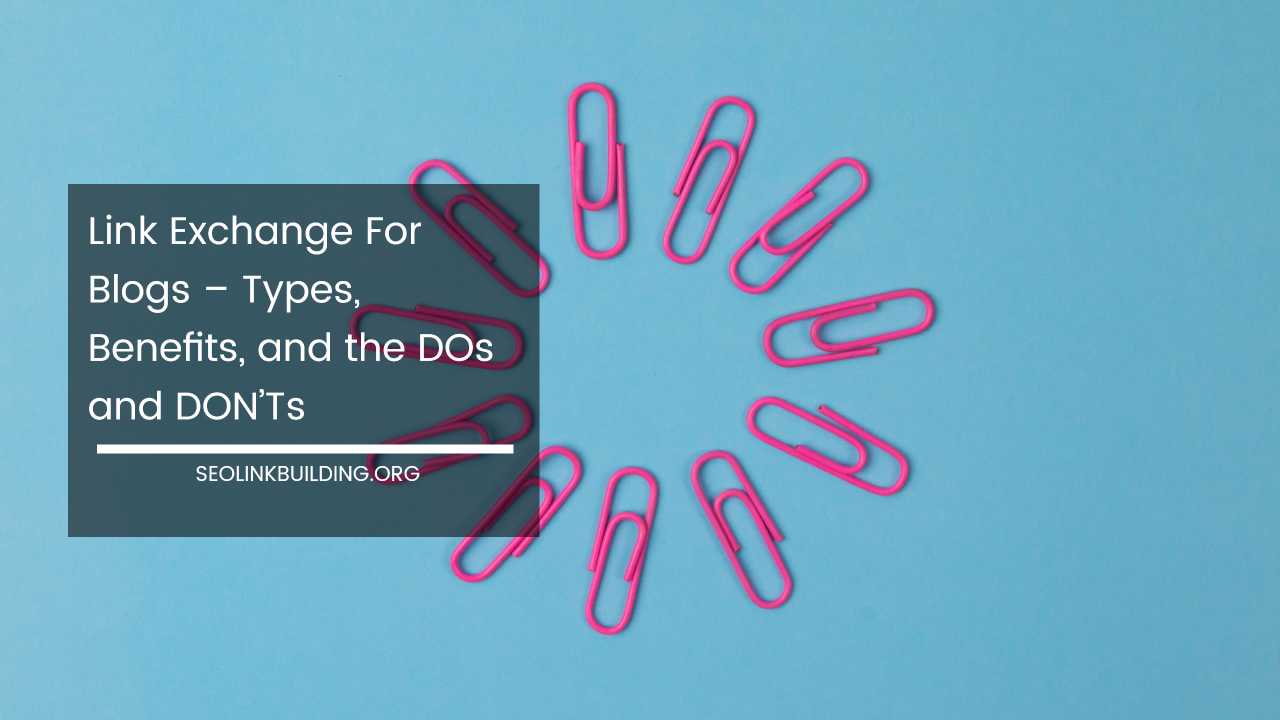Link Exchange For Blogs – Types, Benefits, and the DOs and DON’Ts

Link Exchange for Blogs: Building Relationships, Not Just Backlinks
In the dynamic landscape of SEO (Search Engine Optimization), link building remains a central pillar. Within this realm, link exchange has been a popular tactic for bloggers and website owners. But with Google’s ever-evolving algorithms, the question arises: is link exchange still a viable strategy in 2024?
This comprehensive guide delves deep into link exchange for blogs. We’ll explore the different types, dissect the potential benefits, and equip you with crucial DOs and DON’Ts to navigate this strategy safely and effectively.
Understanding Link Exchange: A Web of Benefits
Link exchange, also known as link swapping or reciprocal linking, is a collaborative agreement between two websites to link to each other’s content.
The core principle is to establish a mutually beneficial relationship where both parties gain backlinks. These backlinks can potentially elevate search engine ranking and drive valuable website traffic.
Delving into the Different Types of Link Exchange
There’s more than one way to approach link exchange. Here’s a breakdown of the various methods:
- Reciprocal Linking: This is the most common form, where Website A links to Website B, and Website B reciprocates by linking back to Website A. While straightforward, overuse can raise red flags for search engines.
- Guest Posting Exchange: This method fosters collaboration. Websites agree to publish guest posts for each other, with each post strategically including a link back to the author’s website. This offers the advantage of content creation and link building rolled into one.
- Three-Way Link Exchange: This method introduces a triangular structure. Website A links to Website B, Website B links to Website C, and Website C completes the loop by linking back to Website A. While it can appear less obvious than reciprocal linking, unnatural patterns can still trigger scrutiny from search engines.
- Private Influencer Networks (PINs): This approach involves a network of websites controlled by a single entity. All websites within the network link to each other, creating a closed loop. Search engines heavily penalize such manipulative practices, so it’s best to avoid PINs altogether.
The Potential Benefits of Link Exchange (When Done Right)
Strategic link exchange offers several advantages for blogs:
- Enhanced Search Engine Ranking: Backlinks remain a crucial ranking factor for search engines like Google. By exchanging links with relevant, high-quality websites, you can increase the number of backlinks pointing to your blog. This can potentially boost your search engine visibility and attract more organic traffic.
- Increased Website Traffic: High-traffic partner websites can be a valuable source of referral traffic. Readers who discover your content through these inbound links may become regular visitors, fostering a loyal audience base.
- Elevated Brand Awareness: Link exchange exposes your blog to a wider audience through partner websites. This broader reach can significantly increase brand awareness and establish your blog as a credible source within your niche.
- Content Collaboration: Link exchange can sometimes spark exciting content collaboration opportunities. Partnering with other bloggers on guest posts or joint projects can lead to fresh content ideas, cross-promotion benefits, and expand your overall reach.
DOs and DON’Ts of Link Exchange: Building a Sustainable Strategy
While link exchange offers potential benefits, it’s crucial to approach it cautiously. Here’s a breakdown of the key DOs and DON’Ts to ensure your link-building strategy remains safe and effective in the long run:
DOs:
- Prioritize Quality Over Quantity: Focus on acquiring links from high-quality, relevant websites within your niche. Partnering with low-quality or irrelevant websites can negatively impact your SEO efforts. Google prioritizes the context and relevance of backlinks, so building genuine connections with established blogs in your field is key.
- Natural Link Placement is King: Ensure links are seamlessly integrated within the content, providing value to the reader’s experience. Avoid forced or unnatural-looking links that disrupt the flow of the content. This can raise red flags for search engines and detract from the user experience.
- Embrace Anchor Text Diversity: Use a variety of relevant anchor text for your links. Anchor text is the clickable text that users see when they encounter a hyperlink. Avoid keyword stuffing in anchor text, as this is a black hat SEO tactic that can lead to penalties. Focus on using natural-sounding phrases that accurately describe the linked content.
- Content First, Links Second: Build relationships with other bloggers based on shared content interests and a genuine desire to collaborate. Don’t solely focus on acquiring links; create valuable, informative content that deserves to be linked to naturally. This establishes your blog as a trusted resource within your niche and attracts organic backlinks over time.
- Monitor Your Backlinks Regularly: Regularly monitor your backlinks to identify any low-quality or spammy links that may be pointing to your website. Disavow such links using Google Search Console to protect your website from potential penalties. Search engines may penalize websites with unnatural backlink profiles, so staying vigilant about your backlink health is crucial.
DON’Ts:
- Don’t Engage in Excessive Reciprocal Linking: Avoid excessive reciprocal linking schemes. Search engines can easily detect unnatural linking patterns, and websites that participate in such practices may face penalties. Focus on building a balanced link profile with a natural distribution of inbound links.
- Stay Away from Automated Link Exchanges: Avoid automated link exchange services or tools. Building genuine relationships with other bloggers in your niche is essential for long-term success. These relationships not only provide valuable backlinks but can also lead to content collaborations and knowledge sharing.
- Don’t Settle for Low-Quality Links: Refrain from linking to or accepting links from low-quality, irrelevant websites. Links from websites with poor reputations or irrelevant content can damage your website’s reputation and SEO performance. Focus on building backlinks from trustworthy, reputable websites within your niche.
- Avoid Keyword Stuffing in Anchor Text: Don’t resort to keyword stuffing your anchor text. This involves excessively repeating your target keyword in the clickable text of your links. Focus on using natural-sounding anchor text relevant to the linked content. Google frowns upon manipulative keyword stuffing practices, and they can negatively impact your SEO efforts.
- Buying or Selling Links is a Big No-No: Buying or selling links is a clear violation of search engine guidelines and can result in severe penalties. Building backlinks should be done organically through the creation of high-quality content and establishing genuine relationships with other bloggers in your niche.
Beyond Link Exchange: Alternative Link-Building Strategies
While link exchange can be a valuable strategy, it’s not the only option for building backlinks. Here are some alternative link-building tactics to consider:
- Create High-Quality Content: The cornerstone of any successful link-building strategy is consistently creating high-quality, informative, and engaging content that establishes you as an authority in your niche. Readers who find your content valuable are more likely to link to it organically, boosting your website’s authority and visibility in search engine results pages (SERPs).
- Guest Posting: Reach out to relevant websites in your niche and offer to write guest posts. This allows you to showcase your expertise on a new platform, gain exposure to a fresh audience, and secure a valuable backlink to your blog. Guest posting is a win-win situation, as you provide valuable content to the host website while promoting your own blog and expertise.
- Broken Link Building: Identify broken links on relevant websites within your niche. Reach out to the website owner and suggest your content as a replacement for the broken link. This is a great way to build backlinks while also helping the website owner improve their content quality.
- Utilize Social Media Promotion: Promote your content on social media platforms to reach a wider audience. Increased social media engagement can lead to organic link building as other websites and bloggers discover and share your valuable content.
- Get Involved in Online Communities: Participate in online communities and forums related to your niche. By providing insightful and informative contributions, you can establish yourself as a thought leader and potentially earn backlinks from other community members who find your expertise valuable.
Final Thoughts: Building a Sustainable Backlink Profile
Link exchange can be a valuable tool for bloggers when used strategically and ethically. By focusing on quality over quantity, prioritizing natural link placements, and building genuine relationships with other bloggers, you can leverage link exchange to enhance your website’s SEO performance and reach a wider audience. However, it’s crucial to remember that link exchange is just one piece of the puzzle.
For long-term success, focus on creating high-quality content, exploring alternative link-building strategies, and consistently monitoring your backlink profile.
This comprehensive approach will help you build a sustainable backlink profile that drives organic traffic, elevates your brand awareness, and establishes your blog as a trusted resource within your niche.













